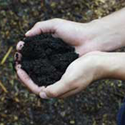
by Roy Carter | Mar 25, 2014

Image Credit UF IFAS Gardening solutions.
What does it mean to grow gardens organically? It depends upon who you talk to. The simple answer is that organic gardeners only use animal or plant-based fertilizers rather than synthetic. It also means use of natural pest control devoid of synthetically manufactured insecticides. In other words, using natural substances and beneficial insects to ward off pests instead of spraying with the backyard equivalent of Malathion. My information on organic vegetable gardening was provided by UF IFAS Extension Publication “Organic Vegetable Gardening” HS 1215.
Why garden organically? Since “USDA Certified Organic” does not apply to home gardening, why would any gardener give up all synthetic fertilizers? And why not use synthetic pesticides, when just one application could eliminate even the most devastating ravages of a crop insect or disease? Why work, so hard handling large quantities or organic soil amendments and manures when synthetic fertilizer of every description and purpose are so quickly available and easy to use?
Early organic gardeners did it to preserve a way of life that reduced pollution and environment decay, thus creating a more ecological society. Organic enthusiasts are extremely health-conscious, and hope that working vigorously outdoors and eating foods free from pesticides just might lead to better nutrition and health.
The biggest differences between organic and conventional gardening are in the area of fertilization and pest control. The organic gardener prefers organic materials and natural methods of dealing with insect problems and fertilizer requirements. The conventional gardener uses a combination of chemically prepared materials and scientific methods in approaching the vegetable garden.
Whichever method you choose, you need to select a plot of good, well-drained soil for planting vegetables. Also, it is important to choose vegetable varieties suited to Florida growing conditions.
Soil preparation is the most important step in organic gardening. Since organic fertilizers and soil conditioning materials work rather slowly, they need to be mixed into the soil at least three weeks ahead of planting time.
To have a successful organic garden, you need to use abundant quantities of organic material, usually in the form of animal manures, cover crops, compost or mixed organic fertilizer. These materials improve the tilth, condition, and structure of the soil. They help the soil hold water and nutrients better. In addition, organic matter supports micro-biological activity in the soil, and contributes major and minor plant nutrients. Another benefit is that as these organic matters decompose, they release acid which help to convert insoluble natural additives, such as ground rock, into forms plants can use.
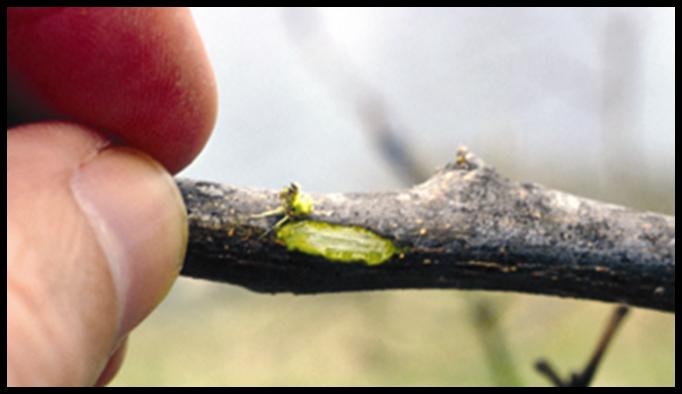
by Roy Carter | Jan 20, 2014
January and February are typically the coldest months in Florida and plants can be damaged by low temperatures. But with your help, cold-damaged plants can often recover.
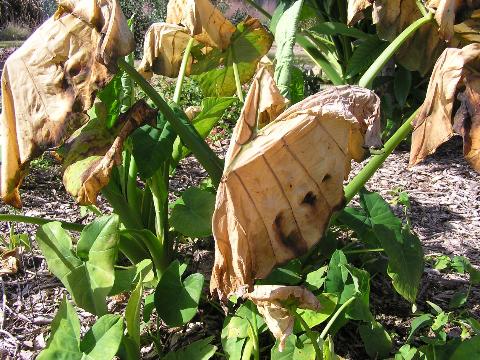
Cold damage on Ornamental. Image Credit Eddie Powell UF IFAS Extension Walton County
After a freeze, see if your plants are dry. Even injured plants need water.
Plants, however can be greatly damaged if the temperature drops suddenly. They have no time to acclimate to the freezing temperatures. Plants are damaged when ice crystals form the plant cells. The crystals expand, rupturing the cell walls and preventing the plants from maintaining shape. If severe, this can kill tender plants. On hardier plants, damaged foliage will appear wilted and curled down. In a few hours or days, it will darken and turn black. Flowers and buds my die, blacken, and drop to the ground if exposed to cold temperatures. Damaged flowers will not develop into fruit. Young branches and new growth are especially susceptible and may also blacken and die.
After freezing temperatures occur, remove damaged leaves and flowers as soon as they turn brown or black. This will help prevent diseases from attacking the plant. Pruning should be postponed until cold temperatures are no longer expected and new growth begins to appear on the plant. This is to make sure that live wood, which appears dead from losing its leaves, is not mistakenly removed from the plant. Cold damaged wood can be detected by examining the cambium layer (under the bark) of the plant. If it has black or brown discoloration, it is damaged and should be pruned back behind those points.

Living cambium layer beneath bark. Image Credit UF IFAS Pinellas County
Protect your plants from cold temperatures during the next cold front. Do this by moving potted plants indoors and covering tender landscape plants with a protective covering. Protective covering can include old bed sheet, pieces of material or fabric, and cardboard boxes. Be careful not to let the protective covering touch the plants. The surface of the covering will become as cold as the air temperatures and may damage any tender leaves it come in contact with. Also, don’t forget to remove the covering the next day when temperature raises this is important so the plants do not “bake” in the warmer temperatures. Plants placed near the house, lights, or other structures, which shelter them from wind, will be more protected than those fully exposed to the cold air.
Whatever you do, even if your landscape ornamentals have already suffered some cold injury. Do not relax your guard more frigid weather may be on the way. So, be prepared to keep your prized plants, as warm as possible, each time the weatherman predicts freezing temperatures. Plants should be fertilized in the spring, to encourage new growth. Try not encouraging any new growth, until all frost danger has passed.
For more information on freeze damaged plants contact your county extension agent and see Publication The North Florida Gardening Calendar
by Roy Carter | Nov 4, 2013
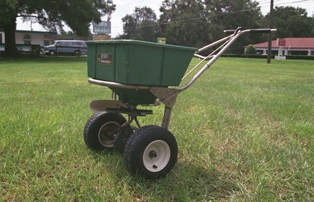
Fertilizer Spreader on lawn. Image Credit UF IFAS Extension FYN Program
Fertilizers are manufactured from a wide variety of materials to supply plant nutrients. Once these materials are mixed, it becomes difficult to distinguish the materials present. In the past, a few unscrupulous manufacturers have taken advantage of this to increase their profit. To protect consumers and legitimate manufacturers from such practices, The Florida legislature enacted the first fertilizer law in 1889 and has amended it many times since enactment. These laws regulate the manufacture and sale of fertilizer in the state.
The law requires that the manufacturer purchase and affix a label to each bag, package, container, or lot of fertilizer offered for sale in the state. The law requires that each label show specific information about the analysis and composition of the mixture or material.
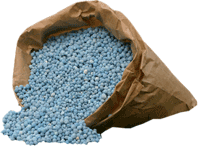
Image Credit UF IFAS
The key information comes in the guaranteed analysis section of the label. It tells the home gardener the ratio by percentage of the primary plant nutrients. The number s are in the order of these primary nutrients; Nitrogen, Phosphorus and Potassium. For example an 8-8-8 fertilizer would be eight percent nitrogen compound, eight percent phosphorus compound and eight percent potassium compound.
There’s some other information in this section of the label that may seem even more complicated but it’s also important. The label explains how much chlorine the fertilizer can contain. Chlorine can reduce the quality of some vegetable and flowers.
It informs the buyer what materials the primary plant nutrients are derived from. This can assist in determining the quality of the fertilizer.
Probably the most difficult part of the label to read, certainly the hardest part to describe, is the information listed right after the total nitrogen figure in the guaranteed analysis section. In addition the total amount of nitrogen, the label gives the amount of each of several types of nitrogen present in the fertilizer. This information will seem confusing, but it also offers a glimpse into how the fertilizer will work in specific types of soil.
Terms such as nitrate nitrogen ammoniacal nitrogen, water-soluble organic nitrogen and/or urea nitrogen can be used by plants fairly quickly. These nitrogen forms in fertilizer are great for a vegetable garden. But nitrate and water-soluble organic nitrogen are rapidly leached out of the soil so they don’t last very long. Ammoniacal and water insoluble nitrogen will stay longer in sandy soils.
Fertilizer with a high percentage of natural organic nitrogen is used by the plants slowly over a fairly long period of time. This kind of slow release fertilizer would be good for lawns helping them stay green without causing spurts of extra fast growth.
This is a complicated subject, hard to fully explain in one article. This is the take home message: almost any fertilizer purchased in Florida is a good one if it has the ingredients required for plant health and if the price is fair in terms of the total amount of plant nutrients it contains.
For more information on Florida fertilizer label contact your local UF IFAS Extension office or read this publication on the Florida Fertilizer Label.
by Roy Carter | May 3, 2013
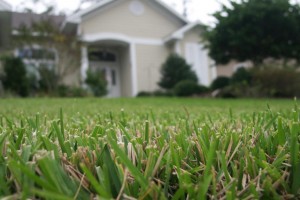
Image Credit: UF / IFAS
A beautiful lawn can add substantial value to a home. While providing an attractive setting for landscape ornamentals, a good lawn will reduce weed growth and prevent erosion. Selecting the proper grass for a specific location is a basic key to attaining these goals.
Five lawngrasses are commonly grown in Florida. Saint Augustine, Bahia, Centipede, Zoyia are most popular, while Carpet is used less often. This article will offer some facts which could assist the home gardener in choosing the best home turf species.
The most important thing to consider when selecting a lawngrass is the compatibility of that grass with the soil, climate, and growing conditions of a specific area. For example, along the coast a salt tolerant grass such as Saint Augustine should be planted. Attempting to grow Centipede or Bahia is asking for trouble. These grasses might be able to be established in a coastal location, but only with considerable expenditures of time and money. Likewise, if grasses are needed for a shaded lawn, plant Saint Augustine or Bahia, not Bermuda, which requires full sun.
After it is determined which lawngrasses will grow well in a given area, one should be chosen that is able to be managed properly. No lawngrass is maintenance free, but some types do require more care than others. For example, Bermuda produces the most beautiful lawns, but only if it’s heavily fertilized, frequently mowed, and kept free of pests and diseases. If a high level of maintenance cannot be provided, it would be wise to plant a low care grass, such as Bahia, or Centipede. Saint Augustine is not difficult to maintain, but thatch and chinch bugs are common problems.
The amount of water a particular grass requires is another consideration. Bahia has excellent drought tolerance Saint Augustine ranks second and Centipede ranks third.
In recent year, dramatic improvements in Zoysia grass have been made by turfgrass breeders. These improvements include insect resistance, accelerated establishment, and overall performance. Zoyiagrasses are adapted to a variety of soil types and have good tolerance to shade, salt, and traffic. They provide and extremely dense sod that resist weed invasion, but certain pest can be problematic.
Out of all Florida Lawngrasses, Bahia is most resistant to pests. It’s the best choice for landscapes heavily infested with nematodes. Saint Augustine also has good nematode tolerance, but chinch bugs are a serious threat to this grass. While it may be severely damaged by nematodes, Centipede has few other pest problems, providing it is not fertilized to heavily. Bermuda is plagued by many problems, in fact, it’s particularly impossible to grow this grass without a continuous control program to cope with nematodes, insects, and diseases.
A a number of good lawngrasses grow well in Florida, but each has certain advantages and disadvantages as well as specific cultural requirements. Area climate, landscape soil type, amount of home site shade and sun, and the degree of traffic by people and pets are important considerations when choosing home lawn truf types.
Information was provided by J. Bryan Unruh, Associate Center Director and Professor, West Florida Research and Education Center, Institute of Food and Agricultural Science, Jay, Florida.
Also, feel free to contact your local county extension agent or refer to these UF / IFAS publications on trufgrass selection.
For more information on choosing a lawngrass contact the author Roy Lee Carter, County Extension Director – Gulf County Florida, at
639-3200.







